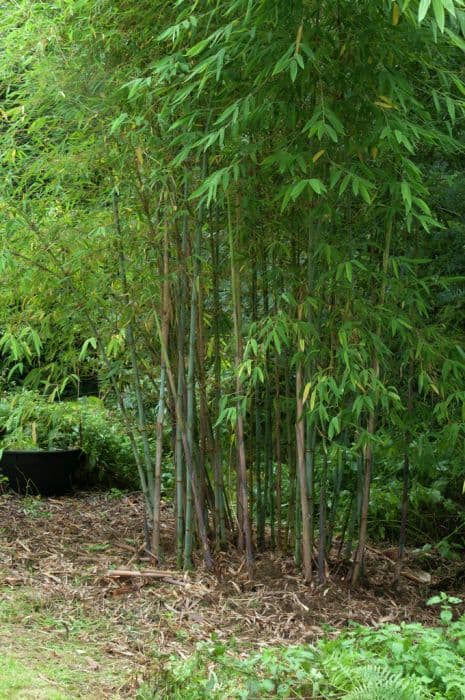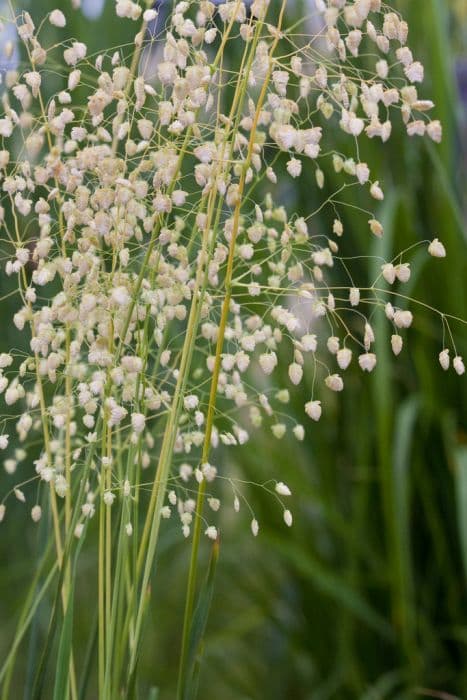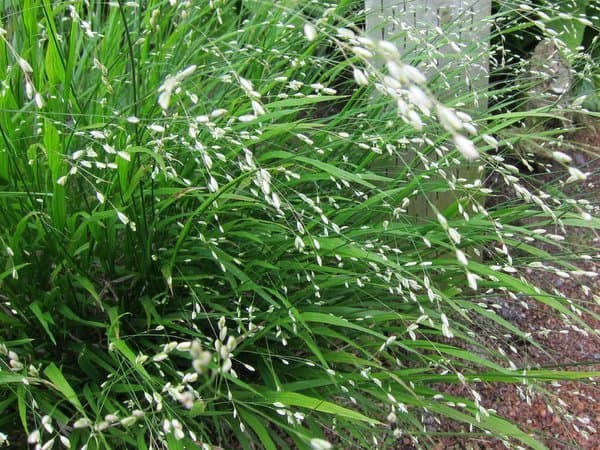Clumping Bamboo Fargesia robusta

ABOUT
Fargesia robusta, commonly known as clumping bamboo, is a species of bamboo characterized by a distinctive appearance. This bamboo variety forms elegant clumps rather than spreading aggressively. It boasts lush green leaves that sprout from its canes, contributing to a dense and bushy look which can provide a solid screen of foliage. The leaves are slender and elongated, typically presenting a fresh, deep green coloration that can be a vibrant addition to any garden space. The canes, also known as culms, are sturdy and upright, often showcasing a green hue that may transition toward a more yellowish or golden color with age or sun exposure. The nodal rings on the canes are quite prominent, giving a rhythmic pattern to the vertical growth. Clumping bamboo has a graceful, arching form, with the foliage often drooping slightly from the weight, thus adding to its ornamental appeal. The overall impression is of a plant that provides a lush, exuberant green presence, ideal for creating natural-looking barriers or for adding a vertical element to a garden design without overwhelming the space with excessive spread.
About this plant
 Names
NamesFamily
Poaceae
Synonyms
Robust Bamboo, Green Screen Bamboo, Wang Tsai
Common names
Fargesia robusta.
 Toxicity
ToxicityTo humans
The Fargesia robusta, commonly known as Robusta bamboo, is not known to be toxic to humans. In general, consumption of any part of this plant does not generally result in poisoning or the presentation of hazardous symptoms. As with any plant material, individual allergies or sensitivities are possible, but there are no widespread reports of toxic reactions in humans from ingesting Robusta bamboo.
To pets
Similarly, the Robusta bamboo is not known to be toxic to pets. It does not contain any known toxins that would cause poisoning in animals such as dogs, cats, or other common household pets. As with humans, consumption of the plant is unlikely to lead to serious health issues. However, pet owners should always be cautious and monitor their animals for any signs of distress after ingesting plant material since gastrointestinal blockages or other non-toxic related issues can occur with the ingestion of non-food items.
 Characteristics
CharacteristicsLife cycle
Perennials
Foliage type
Evergreen
Color of leaves
Green
Height
12-18 feet (3.7-5.5 meters)
Spread
5-8 feet (1.5-2.4 meters)
Plant type
Bamboo
Hardiness zones
7
Native area
China
Benefits
 General Benefits
General Benefits- Ornamental appeal: Fargesia robusta, commonly known as Clumping Bamboo, offers aesthetic beauty with its lush green foliage and upright growth habit, making it an attractive addition to gardens and landscapes.
- Privacy screen: Due to its dense growth, Clumping Bamboo is excellent for creating private areas within a garden or serving as a green fence between properties.
- Noise reduction: The thick foliage of Clumping Bamboo can help dampen urban noise, providing a quieter, more tranquil garden environment.
- Erosion control: The root system of Clumping Bamboo helps to stabilize soil on slopes and prevent erosion, making it valuable for landscaping in challenging areas.
- Habitat for wildlife: Clumping Bamboo can offer shelter and food for various species of birds, insects, and small mammals, contributing to biodiversity in your garden.
- Shade provider: Its tall and dense growth pattern allows it to provide cooling shade in garden spaces that can lower temperatures and create comfortable outdoor living areas.
- Low maintenance: Clumping Bamboo is relatively easy to care for and does not spread aggressively like some other bamboo species, requiring less management and upkeep.
- Drought tolerance: Once established, Clumping Bamboo has a high tolerance for drought, making it suitable for xeriscaping and water-efficient gardens.
 Medical Properties
Medical PropertiesThis plant is not used for medical purposes.
 Air-purifying Qualities
Air-purifying QualitiesThis plant is not specifically known for air purifying qualities.
 Other Uses
Other Uses- Fargesia robusta, commonly known as clumping bamboo, can be used as a natural sound barrier due to its dense growth which helps absorb noise effectively.
- Its sturdy canes can be employed as garden stakes for supporting other plants or for creating simple structures in the garden such as trellises.
- The clumping bamboo's dense growth habit offers privacy screens for homes or outdoor spaces, providing a green and aesthetically pleasing alternative to fences.
- Collected rainwater in the bamboo's dense leaves can provide a water source for birds and insects, creating a mini-ecosystem within the garden.
- Dried leaves of the clumping bamboo can be used as a natural mulch to retain soil moisture and reduce weed growth in gardens.
- The plant's root system can help stabilize soil on slopes, preventing erosion and landslides by holding the soil firmly in place.
- Culms (stems) of Fargesia robusta can be used in the creation of musical instruments like flutes, known for its quality sound due to the bamboo's density and strength.
- Mature stems can be utilized to craft furniture or decorative items, capitalizing on the wood's durability and appearance.
- The shoot sheaths of clumping bamboo can serve as natural containers for seedling propagation before the seedlings are big enough to be planted directly in the ground.
- The plant's dense foliage provides excellent habitat and shelter for various bird species, promoting biodiversity in gardens or natural landscapes.
Interesting Facts
 Feng Shui
Feng ShuiFargesia robusta, commonly known as clumping bamboo, can be used in Feng Shui to attract positive Chi, promote privacy, and create barriers against negative energy. It's especially valued for its growth pattern which doesn't invade the neighboring space, symbolizing respectful boundaries. According to Feng Shui, placing clumping bamboo in the east side of the garden can boost family health and the southeast to enhance wealth and abundance.
 Zodiac Sign Compitability
Zodiac Sign CompitabilityThe clumping bamboo is not used in astrology practice.
 Plant Symbolism
Plant Symbolism- Resilience: Fargesia robusta, commonly known as clumping bamboo, is known for its sturdy nature and ability to thrive in various conditions, symbolizing one's ability to withstand adversity.
- Growth: As a bamboo species, it represents rapid growth and versatility, both physically and metaphorically, in personal or professional life.
- Flexibility: The flexible stems of clumping bamboo allow it to bend in the wind without breaking, symbolizing flexibility and adaptation in life's challenges.
- Privacy: Given its use as a natural screen, it embodies the value of privacy and the need for personal space or boundaries.
- Good Fortune: In many Asian cultures, bamboo is considered lucky and is often associated with prosperity, progress, and longevity.
 Water
WaterClumping bamboo should be watered deeply to keep the soil consistently moist but not waterlogged. During the growing season, it generally requires watering at least once a week, but you may need to water more often during hot, dry spells to maintain proper moisture levels. When watering, apply approximately 1 gallon of water per square yard of soil to ensure it reaches the root zone. In cooler months or dormant periods, reduce the frequency to correspond with reduced growth and evaporation rates, monitoring the soil moisture to guide your schedule.
 Light
LightClumping bamboo thrives in bright, indirect sunlight but can adapt to partial shade. The best spot for the plant is a location where it can receive morning sunlight and afternoon shade, or dappled light throughout the day. Avoid placing it in direct, hot afternoon sun as it can cause leaf scorch.
 Temperature
TemperatureClumping bamboo prefers temperatures between 40°F and 90°F, but can withstand dips down to 20°F and spikes up to 100°F for short periods. The ideal conditions for this plant are a temperate and consistent environment without extremes, as dramatic fluctuations can stress the plant.
 Pruning
PruningClumping bamboo occasionally requires pruning to maintain its shape and encourage healthy growth. Prune in late winter or early spring before new shoots emerge, removing any dead or weak canes and thinning out older, less productive ones to make room for new growth. Aim to prune once a year or as needed to control the size and shape of the plant.
 Cleaning
CleaningAs needed
 Soil
SoilClumping bamboo (Fargesia robusta) thrives in a well-draining soil mix with high organic content. A mix of two parts loam, one part peat, and one part perlite or sand works well. The ideal soil pH for this bamboo should be slightly acidic to neutral, around 6.0 to 6.5.
 Repotting
RepottingClumping bamboo should be repotted every two to three years to prevent it from becoming root-bound and to refresh the soil. It's best to repot in the spring, just before the growing season.
 Humidity & Misting
Humidity & MistingClumping bamboo prefers consistently high humidity levels. Ideal humidity range for Fargesia robusta is between 40% to 60% to maintain healthy growth and lush foliage.
 Suitable locations
Suitable locationsIndoor
Use bright, indirect light and high humidity.
Outdoor
Plant in partial shade, shelter from strong winds.
Hardiness zone
7-9 USDA
 Life cycle
Life cycleFargesia robusta, commonly known as clumping bamboo, begins its life as a seed, germinating in moist, fertile soil to produce a small shoot. The shoot rapidly develops into a young bamboo plant, with distinctive narrow leaves emerging from its nodes. As it enters the vegetative stage, the bamboo experiences vigorous growth, characterized by the production of new culms (stems) that emerge from the ground and grow rapidly in both height and girth. During its reproductive phase, which can occur unpredictably and sometimes not for several decades, Fargesia robusta flowers profusely, after which the parent plant typically dies. The resulting seeds disperse, continuing the life cycle if they land in suitable growing conditions. This plant does not flower frequently; many clumping bamboos have a flowering cycle that can be as long as 80-130 years.
 Propogation
PropogationPropogation time
Spring to summer
The most popular method of propagating Fargesia robusta, commonly known as clumping bamboo, is through division. This is typically done in the spring when the plant is actively growing. To propagate by division, a mature clump is carefully dug up and a sharp spade or knife is used to divide the root mass into smaller sections, making sure that each division has at least one or two viable culms (stems) and a portion of the root system intact. The divisions are then replanted in a suitable location, where they should be watered regularly to establish roots. The planting depth should be similar to the original growing conditions to encourage successful propagation.









